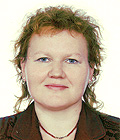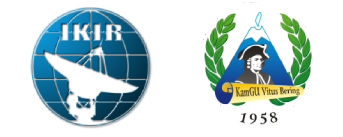Вестник КРАУНЦ. Физ.-мат. науки. 2020. Т. 31. № 2. C. 129-138. ISSN 2079-6641
Содержание выпуска/Contents of this issue
ПРИБОРЫ И МЕТОДЫ ИЗМЕРЕНИЙ
Научная статья
УДК 550.35
Особенности сезонной динамики изотопов радона в приземной атмосфере
Г. А. Яковлев¹, В. С. Яковлева²
¹Томский государственный университет, 634050, г. Томск, пр. Ленина, 36, Россия
²Томский политехнический университет, 634050, г. Томск, пр. Ленина, 30, Россия
E-mail: vsyakovleva@tpu.ru
Исследованы особенности временной динамики изотопов радона и дочерних продуктов их распада для климатических условий Сибири (Российская Федерация). Анализ результатов выявил специфическую сезонную динамику радона: максимальное значение наблюдается зимой, а минимальное — весной. Совершенно другое поведение было обнаружено для торона. Минимальные значения наблюдаются зимой, а максимальные — в теплый период года. Было установлено, что наличие и характеристики снежного покрова сильно влияют на сезонные колебания объемной активности торона. Осадки оказывают
существенное влияние на сезонную динамику объемной активности продуктов распада радона. Атмосферная турбулентность сильно влияет на суточную динамику всех характеристик поля радона. Было отмечено, что суточные изменения объемной активности
радона и торона четко выражены в периоды без дождя или снега. Максимум объемной активности радона наблюдается в предрассветные часы, а минимум — в дневное время. Кроме того, суточные изменения радона зимой характеризуются утренним максимумом в 8-9 часов, что на 1-2 часа позже, чем в летний период.
Ключевые слова: радон, торон, изотоп, дочерний продукт распада, атмосфера, динамика, метеорологическая величина
DOI: 10.26117/2079-6641-2020-31-2-129-138
Поступила в редакцию: 25.03.2020
В окончательном варианте: 13.05.2020
Для цитирования. Яковлев Г. А., Яковлева В. С. Особенности сезонной динамики изотопов радона в приземной атмосфере // Вестник КРАУНЦ. Физ.-мат. науки. 2020. Т. 31. № 2. C. 129-138. DOI: 10.26117/2079-6641-2020-31-2-129-138
Конкурирующие интересы. Авторы заявляют, что конфликтов интересов в отношении авторства и публикации нет.
Авторский вклад и ответственность. Все авторы участвовали в написании статьи и полностью несут ответственность за предоставление окончательной версии статьи в печать. Окончательная версия рукописи была одобрена всеми авторами.
Контент публикуется на условиях лицензии Creative Commons Attribution 4.0 International
(https://creativecommons.org/licenses/by/4.0/deed.ru)
© Яковлев Г. А., Яковлева В. С., 2020
Список литературы (ГОСТ)
- Podstawczy´nska A. et al. Seasonal and diurnal variation of outdoor radon (222Rn) concentrations in urban and rural area with reference to meteorological conditions // Nukleonika. 2010. vol. 55. no. 4. pp. 543-547.
- Pal S., M. Lopez, M. Schmidt, M. Ramonet, F. Gibert, I. Xueref-Remy, and P. Ciais. Investigation of the atmospheric boundary layer depth variability and its impact on the 222Rn concentration at a rural site in France // J. Geophys. Res. Atmos. 2015. vol. 120. pp. 623–643. doi:10.1002/2014JD022322
- Barbosa S. M. et al. Multiyear to daily radon variability from continuous monitoring at the Amram tunnel, southern Israel // Geophysical Journal International. 2010. vol. 182. no. 2. pp. 829-842.
- Baciu A. C. Radon and thoron progeny concentration variability in relation to meteorological conditions at Bucharest (Romania) // Journal of environmental radioactivity. 2005. vol. 83. no. 2. pp. 171-189.
- Tchorz-Trzeciakiewicz D. E., Klos M. Factors affecting atmospheric radon concentration, human health, Science of the Total Environment // Science of the Total Environment. 2017. vol. 584–585. pp. 911–920.
- Chen X. et al. Responses of the atmospheric concentration of radon-222 to the vertical mixing and spatial transportation // Boreal Environ. Res. 2016. vol. 21. pp. 299-318.
- Kim W. H. et al. Background Level of Atmospheric Radon-222 Concentrations at Gosan Station, Jeju Island, Korea in 2011 //Bull. Korean Chem. Soc. 2014. vol. 35. no. 4. pp. 1149.
- Hol ´y K. et al. Outdoor 222Rn behaviour in different areas of Slovakia // Nukleonika. 2016. vol. 61. no. 3. pp. 281-288.
- Hayashi K. et al. Normal seasonal variations for atmospheric radon concentration: a sinusoidal model // Journal of environmental radioactivity. 2015. vol. 139. pp. 149-153.
- Tchorz-Trzeciakiewicz D. E., Solecki A. T. Seasonal variation of radon concentrations in atmospheric air in the Nowa Ruda area (Sudety Mountains) of southwest Poland // Geochemical Journal. 2011. vol. 45. no. 6. pp. 455-461.
INSTRUMENTS AND METHODS OF MEASUREMENT
Research Article
MSC 86A10
Features of seasonal dynamics of radon isotopes in surface atmosphere
G. A. Yakovlev¹, V. S. Yakovleva²
¹Tomsk State University, Tomsk, Lenina avenue, 36, Russia
²Tomsk Polytechnic University, Tomsk, Lenina avenue, 30, Russia
E-mail: vsyakovleva@tpu.ru
Features of seasonal dynamics of radon isotopes and their decay products were investigated for Siberian (Russian Federation) climatic conditions. The analysis of results revealed a specific in the seasonal dynamics of radon: the maximum value is observed in winter, and the minimum—in spring. A completely different behavior was revealed for thoron. Minimal values are observed in winter and maximal values—in the warm period of the year. It was found that the presence and characteristics of snow cover greatly influence the seasonal variations in thoron volume activity. Precipitation has a significant impact on the seasonal dynamics of the radon decay products volumetric activity. Atmospheric turbulence strongly influences the daily dynamics of all the characteristics of the radon field. It was observed that diurnal variations of radon and thoron volumetric activity are clearly expressed during periods without rain or snow. The maximum of radon volumetric activity is observed in the pre-dawn hours, and the minimum—in the daytime. Moreover, diurnal variations of radon in the winter are characterized by a morning maximum of 8-9 o’clock, which is 1-2 hours later compared to the summer period.
Key words: radon, thoron, isotope, daughter decay product, atmosphere, dynamics, meteorological parameter.
DOI: 10.26117/2079-6641-2020-31-2-129-138
Original article submitted: 25.03.2020
Revision submitted: 13.05.2020
For citation. Yakovlev G. A., Yakovleva V. S. Features of seasonal dynamics of radon isotopes in surface atmosphere.Vestnik KRAUNC. Fiz.-mat. nauki. 2020, 31: 2, 129-138. DOI: 10.26117/2079-6641-2020-31-2-129-138
Competing interests. The authors declare that there are no conflicts of interest regarding authorship and publication.
Contribution and Responsibility. All authors contributed to this article. Authors are solely responsible for providing the final version of the article in print. The final version of the manuscript was approved by all authors.
The content is published under the terms of the Creative Commons Attribution 4.0 International
License (https://creativecommons.org/licenses/by/4.0/deed.ru)
© Yakovlev G. A., Yakovleva V. S., 2020
Список литературы/References
- Podstawczy´nska A. et al., “Seasonal and diurnal variation of outdoor radon (222Rn) concentrations in urban and rural area with reference to meteorological conditions”, Nukleonika, 55:4 (2010), 543-547.
- Pal S. et al., “Investigation of the atmospheric boundary layer depth variability and its impact on the 222Rn concentration at a rural site in France”, J. Geophys. Res. Atmos., 120 (2015), 623–643.
- Barbosa S. M. et al., “Multiyear to daily radon variability from continuous monitoring at the Amram tunnel, southern Israel”, Geophysical Journal International, 182:2 (2010), 829-842.
- Baciu A. C., “Radon and thoron progeny concentration variability in relation to meteorological conditions at Bucharest (Romania)”, Journal of environmental radioactivity, 83:2 (2005), 171-189.
- Tchorz-Trzeciakiewicz D. E., Klos M., “Factors affecting atmospheric radon concentration, human health, Science of the Total Environment”, Science of the Total Environment, 584-585 (2017), 911-920.
- Chen X. et al., “Responses of the atmospheric concentration of radon-222 to the vertical mixing and spatial transportation”, Boreal Environ. Res., 21 (2016), 299-318.
- Kim W. H. et al., “Background Level of Atmospheric Radon-222 Concentrations at Gosan Station, Jeju Island, Korea in 2011”, Bull. Korean Chem. Soc., 35:4 (2014), 1149.
- Holy K. et al., “Outdoor 222Rn behaviour in different areas of Slovakia”, Nukleonika, 61:3 (2016), 281-288.
- Hayashi K. et al., “Normal seasonal variations for atmospheric radon concentration: a sinusoidal model”, Journal of environmental radioactivity, 139 (2015), 149-153.
- Tchorz-Trzeciakiewicz D. E., Solecki A. T., “Seasonal variation of radon concentrations in atmospheric air in the Nowa Ruda area (Sudety Mountains) of southwest Poland”, Geochemical Journal, 45:6 (2011), 455-461.

Яковлев Григорий Алексеевич – студент Томского государственного университета, г. Томск, Россия, ORCID 0000-0001-7842-5672.
Yakovlev Grigory Alekseevich — student of Tomsk State University, Tomsk, Russia, ORCID 0000-0001-7842-5672.

Яковлева Валентина Станиславовна – доктор технических наук, доцент, профессор отделения ядерно-топливного цикла, Национальный исследовательский Томский политехнический университет, г. Томск, Россия, ORCID 0000-0002-5274-0735.
Yakovleva Valentina Stanislavovna — Dr. Sci. (Tech.), Associate Professor, Professor of nuclear fuel cycle department, National Research Tomsk Polytechnic University, Tomsk, Russia, ORCID 0000-0002-5274-0735.

